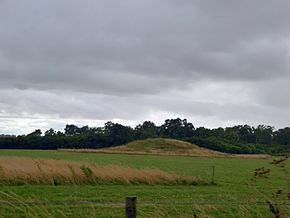Normanton Down Barrows

Round barrow on Normanton Down
|
|
| Location | grid reference SU120412 |
|---|---|
| Coordinates | 51°10′12″N 1°49′48″W / 51.170°N 1.830°W |
| Type | Round barrow cemetery |
| Part of | Stonehenge ritual landscape |
| Length | 1km |
| History | |
| Periods | Bronze Age |
| Site notes | |
| Excavation dates | 18th and 19th centuries |
| Archaeologists | William Cunnington and others |
| Ownership | Part is managed as RSPB Reserve |
| Public access | Crossed by two bridleways |
| Official name | Stonehenge, Avebury and Associated Sites |
| Type | Cultural |
| Criteria | i, ii, iii |
| Designated | 1986 (10th session) |
| Reference no. | 373 |
| Region | Europe and North America |
| Designated | 1925 |
| Reference no. | (west to east): 1009617, 1009618, 1009614, 1009615, 1009616, 1010330 |
Normanton Down is a Neolithic and Bronze Age barrow cemetery located about 0.6 miles (1 km) south of Stonehenge in Wiltshire, England. The burials date from between 2600 and 1600 BC and consist of a Neolithic long barrow and some 40 or more Bronze Age round barrows, sited along the crest of a low ridge.
The barrows of Normanton Down, visible from Stonehenge along the southern horizon, have been part of the scenery of Salisbury Plain since 2000 BC. Barrow excavation was a popular hobby in the 18th and 19th centuries among amateur archaeologists, who became known as "barrow-diggers." In 1808, William Cunnington and Sir Richard Colt Hoare excavated several of the barrows, including the most important barrow, the Bush Barrow. Almost all of these barrows are believed to be from the Bronze Age, but several features, including a Long barrow, are earlier, dating to neolithic times. Cunnington and Hoare noted four sets of "curiously huddled together" human remains in the east end of the Long barrow. Unlike many of the early excavations, Hoare published a detailed account of their findings in 1812. South of the long barrow lies a mortuary enclosure; this rectangular neolithic earthwork, now ploughed out, was discovered by aerial photography and excavated in 1959.
Legal protection for many of the barrows was introduced in 1925 when they were designated a scheduled monument. The area was designated a World Heritage Site in 1987, since which excavation of any sort has been even more strictly controlled. Recent study has therefore focussed on re-appraising existing finds and non-intrusive fieldwork. In 2007, researchers from the University of Birmingham, funded by the Leverhulme Trust, began intensive studies of the artefacts found in all British Bronze Age burials, including those at Bush Barrow; and in 2010 an extensive survey of the condition and context of the barrows was made by English Heritage, as part of their Stonehenge World Heritage Site Landscape Project.
...
Wikipedia

